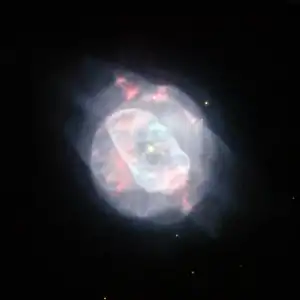| Emission nebula | |
|---|---|
| Planetary nebula | |
 | |
| Observation data: J2000 epoch | |
| Right ascension | 15h 16m 49.95679s[1] |
| Declination | −45° 38′ 58.6109″[1] |
| Distance | 7.7 kly (2.4 kpc)[2] ly |
| Apparent dimensions (V) | 13–14″[3] |
| Constellation | Lupus |
| Designations | ESO 274-7, IC 1168,[4] NGC 5882[5] |
NGC 5882 is a small[4] planetary nebula[3] in the southern constellation of Lupus, positioned about 1.5° to the southwest of the star Epsilon Lupi.[6] It was discovered by English astronomer John Herschel on July 2, 1834 from the Cape of Good Hope observatory.[4] John L. E. Dreyer described it as "very small, round, quite sharp".[7] It is located at a distance of approximately 7.7 kilolight-years from the Sun.[2]
This nebular region consists of the cast-off outer atmosphere of an aging star. It is roughly elliptical in shape with several clumps of ionized material, and is surrounded by a larger region of low-level emission that extends for three times the nominal diameter of the main nebula.[3] The nebula is expanding with an average velocity of 12.5 km/s. It consists of two shells: the inner shell is elliptical and measures 11″ × 6″, while the more rapidly expanding outer shell is rounder with a diameter of 15″. The inner shell has what appears to be multiple bubble-like shapes. The clumps in the outer shell may be the result of instabilities.[8]
The elemental abundances of the nebula are very similar to those in the Sun, except for a times two enrichment of nitrogen. The latter suggests that the central star did not go through second dredge-up. The central star has an apparent visual magnitude of 13.43. It shines with 830 times the luminosity of the Sun and has 22.7% of the Sun's radius.[3] It is displaced slightly from the center of symmetry for the nebula.[8]
References
- 1 2 Brown, A. G. A.; et al. (Gaia collaboration) (August 2018). "Gaia Data Release 2: Summary of the contents and survey properties". Astronomy & Astrophysics. 616. A1. arXiv:1804.09365. Bibcode:2018A&A...616A...1G. doi:10.1051/0004-6361/201833051. Gaia DR2 record for this source at VizieR.
- 1 2 Stanghellini, Letizia; et al. (December 2008), "The Magellanic Cloud Calibration of the Galactic Planetary Nebula Distance Scale", The Astrophysical Journal, 689 (1): 194–202, arXiv:0807.1129, Bibcode:2008ApJ...689..194S, doi:10.1086/592395, S2CID 119257242
- 1 2 3 4 Pottasch, S. R.; et al. (August 2004). "Abundances of Planetary Nebulae IC 418, IC 2165 and NGC 5882". Astronomy and Astrophysics. 423 (2): 593–605. Bibcode:2004A&A...423..593P. doi:10.1051/0004-6361:20040413.
- 1 2 3 O'Meara, Stephen James (April 8, 2013). Deep-Sky Companions: Southern Gems. Cambridge University Press. p. 279. ISBN 9781139851541.
- ↑ "NGC 5882". SIMBAD. Centre de données astronomiques de Strasbourg. Retrieved 2020-02-25.
- ↑ Sinnott, Roger W.; Perryman, Michael A. C. (1997). Millennium Star Atlas. Vol. 2. Sky Publishing Corporation and the European Space Agency. p. 948. ISBN 0-933346-83-2.
- ↑ Seligman, Courtney. "New General Catalogue objects: NGC 5850 - 5899". cseligman.com. Retrieved 2020-09-20.
- 1 2 Corradi, Romano L. M.; et al. (October 2000). "Knots in the Outer Shells of the Planetary Nebulae IC 2553 and NGC 5882". The Astrophysical Journal. 542 (2): 861–869. arXiv:astro-ph/0003238. Bibcode:2000ApJ...542..861C. doi:10.1086/317041. S2CID 18811052.
External links
 Media related to NGC 5882 at Wikimedia Commons
Media related to NGC 5882 at Wikimedia Commons